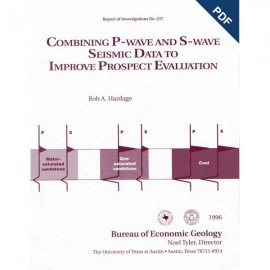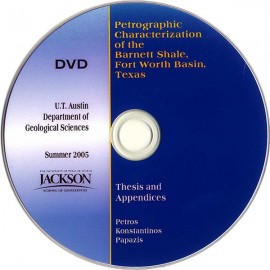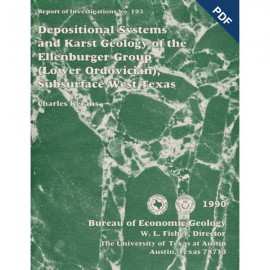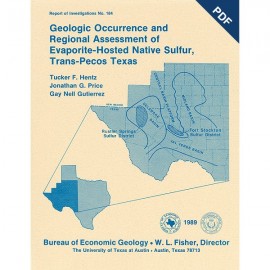Geological Circulars
-
Books & Reports
- Reports of Investigations
- Guidebooks
- Udden Series
- Geological Circulars
- Down To Earth
- Atlases of Major Oil and Gas Reservoirs
- Texas Memorial Museum Publications
- Environmental Geologic Atlas of the Texas Coastal Zone
- Mineral Resource Circulars
- Other Reports
- Seminars and Workshops
- Handbooks
- Submerged Lands of Texas
- Symposia
- Annual Reports
- Open File Reports
-
Maps & Cross Sections
- Thematic Maps
- Miscellaneous Maps, Charts & Sections
- Geologic Atlas of Texas
- STATEMAP Project Maps
- Geologic Quadrangle Maps
- Cross Sections
- Highway Geology Map
- Energy and Mineral Resource Maps
- Shoreline Change and Other Posters
- Wilcox Group, East Texas, Geological / Hydrological Folios
- Bouguer Gravity Atlas of Texas
- River Basin Regional Studies
- Featured Maps
- Posters
- Teachers & the Public
-
Geological Society Publications
- Gulf Coast Association of Geological Societies
- Alabama Geological Society
- Austin Geological Society
- Corpus Christi Geological Society
- Houston Geological Society
- Lafayette Geological Society
- Mississippi Geological Society
- New Orleans Geological Society
- South Texas Geological Society
- GCS SEPM Publications
- Historic BEG & UT Series
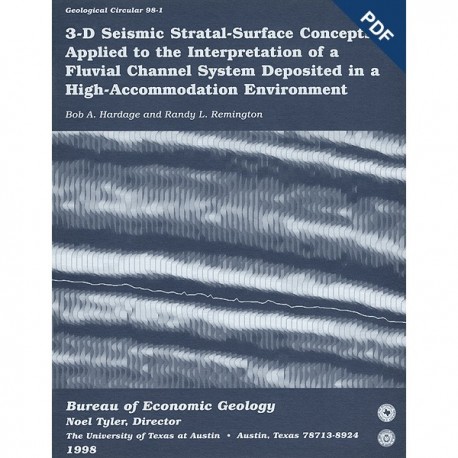
3-D Seismic Stratal-Surface Concepts Applied...Digital Download
GC9801D
For a print version: GC9801.
GC9801D. 3-D Seismic Stratal-Surface Concepts Applied to the Interpretation of a Fluvial Channel System Deposited in a High-Accommodation Environment, by B. A. Hardage and R. L. Remington. 15 p., 15 figs., 1998. Downloadable PDF. ISSN: 2475-3637. doi.org/10.23867/gc9801D.
To purchase this publication in book format, please order GC9801.
ABSTRACT
A fundamental thesis of seismic stratigraphy is that seismic reflections follow impedance contrasts that coincide with stratal surfaces, which are surfaces where depositional processes occur at a fixed moment in geologic time. This stratal-surface concept is used herein to image a narrow (width--300 ft), thin, fluvial channel system that is embedded within a seismic reflection peak. The peak reflects from a large (about 2- x 2-mi) area where nonchannel facies dominate its waveshape. The targeted channel facies are confined to an interval that vertically spans less than 30 ft. According to principles of seismic stratigraphy, four conformable seismic stratal surfaces that pass through the interior of this channel sequence were constructed across a 2- x 2-mi (approximately) area of a 3-D seismic-data volume. The channel images portrayed on these seismic horizons, which were spaced at vertical increments of 2 ms, illustrate the principle that seismic attributes viewed on seismic stratal surfaces provide valuable images of facies distributions within thin-bed sequences and help seismic interpreters segregate channel facies from nonchannel facies. These stratal-surface interpretations of the fluvial system were then integrated to create a thin (8-ms-kck), stratal-bounded seismic-data window that spans the short geologic time period during which the targeted fluvial depositional system was active. Seismic-attribute calculations within this stratalbounded analysis window improve parts of the channel image by integrating the facies information from all stratal surfaces into a unified seismic attribute that vertically spans the total depositional sequence. A comparison is made between channel images on seismic stratal surfaces that are conformable to two different reference surfaces, one reference surface being positioned below the targeted fluvial system and the second reference surface being above the h-bed channels. This comparison supports the premise that seismic interpreters should extrapolate stratal surfaces both upward and downward across a thin-bed target to optimize the image of that target.
Keywords: seismic stratigraphy, stratal surfaces, thin-bed interpretation
CONTENTS
Abstract
Introduction
Color Bar Used for Data Displays
Surface View of Targeted Fluvial System
Vertical Views of Channel and Nonchannel Seismic Facies
Crossline 174
Crossline 200
Crossline 222
Stratal-Surface Images of Channel Systems
Stratal-Bounded Seismic Analysis Windows
Combining Upward and Downward Extrapolations of Seismic Stratal Surfaces to Improve Thin-Bed Interpretation
Conclusions
Acknowledgments
References
Figures
1. 3-D seismic image of the targeted thin-bed Miocene fluvial channel system
2. Data window from crossline 174 centered on the northern, smaller channel system
3. Data window from crossline 174 centered on the southern, larger channel system
4. Data window from crossline 174 showing stratal surfaces that traverse the northern, smaller channel system
5. Data window from crossline 174 showing stratal surfaces that traverse the southern, larger channel system
6. Data window from crossline 200
7. Data window from crossline 200 showing stratal surfaces that traverse channel facies
8. Data window from crossline 222 centered on selected point-bar facies
9. Data from crossline 222 showing stratal surfaces that traverse point-bar facies
10. Reflection-amplitude behavior on stratal surface A. which is 92 ms above, and conformable to, the selected reference surface
11. Reflection-amplitude behavior on stratal surface B. which is 90 ms above, and conformable to, the selected reference surface
12. Reflection-amplitude behavior on stratal surface C. which is 88 ms above, and conformable to, the selected reference surface
13. Reflection-amplitude behavior on stratal surface D. which is 86 ms above, and conformable to, the selected reference surface
14. Average amplitude of reflection peaks in a thin, stratal-bounded window spanning the targeted Miocene fluvial sequence
15. Location of reference-surface 2 on crossline 200
Citation
Hardage, B. A., and Remington, R. L., 1998, 3-D Seismic Stratal-Surface Concepts Applied to the Interpretation of a Fluvial Channel System Deposited in a High-Accommodation Environment: The University of Texas at Austin, Bureau of Economic Geology, Geological Circular 98-1, 15 p. doi.org/10.23867/gc9801D.

